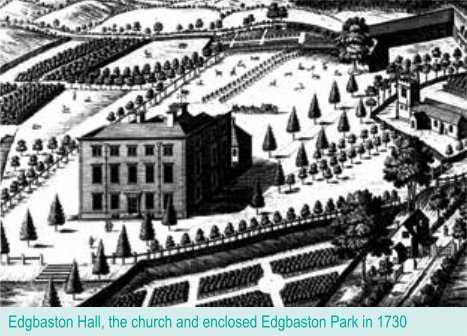Celboldestone in the Domesday book of 1086 is thought to refer to Edgbaston and depicts it as an area of cultivated land of about 250 acres.
Edgbaston Church dates from the 13th century and Edgbaston Hall, the manor house, now Edgbaston Golf Club, somewhat later. During the English Civil War, when Edgbaston Hall was the seat of Robert Middlemore, a Roman Catholic and Royalist, Parliamentarian troops extensively damaged the church and took over the Hall, which was eventually destroyed.
In 1717, the Middlemore line having been extinguished, the lordship of Edgbaston was purchased by Sir Richard Gough. During 10 years at Edgbaston he rebuilt both the Hall and the church.
The Hall was tenanted in 1796 by William Withering who became a member of the Lunar Society, a group of eminent men such as James Watt, Joseph Priestley and Matthew Boulton. They were feared by the common people and when celebrating the 2nd anniversary of the storming of the Bastille, were attacked by a mob. The Hall was threatened but successfully defended and the arrival of military support from Birmingham ended the riot.
The Goughs married into the Calthorpe family and the Calthorpe Estate continues to dominate Edgbaston to this day, many roads being named after family members. Edgbaston Hall, the church and enclosed Edgbaston Park in 1730 Sir Henry Gough Calthorpe - created 1st Baron Calthorpe 1796.
From the early 19th century the migration of wealthy manufacturers from the city to the leafy suburb ousted the tenant farmers and allowed the building of large elegant houses on tree-lined streets. No trade or manufacturing was allowed on the estate. However, concessions were occasionally made during the 19th century, e.g. for the Royal Institute for the Blind, the Institute for the Deaf and Dumb, the Birmingham Botanical Gardens, the Oratory and its school, and land for the Warwickshire County Cricket Club.
Birmingham Botanical and Horticultural Society obtained a lease on land off Westbourne Road and ten acres of the Botanical Gardens were first opened to the shareholders of the Society in 1832.



